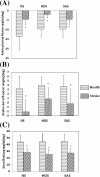Speed-adaptive control of functional electrical stimulation for dropfoot correction
- PMID: 30400918
- PMCID: PMC6220509
- DOI: 10.1186/s12984-018-0448-x
Speed-adaptive control of functional electrical stimulation for dropfoot correction
Abstract
Background: Functional electrical stimulation is an important therapy technique for dropfoot correction. In order to achieve natural control, the parameter setting of FES should be associated with the activation of the tibialis anterior.
Methods: This study recruited nine healthy subjects and investigated the relations of walking speed with the onset timing and duration of tibialis anterior activation. Linear models were built for the walking speed with respect to these two parameters. Based on these models, the speed-adaptive onset timing and duration were applied in FES-assisted walking for nine healthy subjects and ten subjects with dropfoot. The kinematic performance of FES-assisted walking triggered by speed-adaptive stimulation were compared with those triggered by the heel-off event, and no-stimulation walking at different walking speeds.
Results: Higher ankle dorsiflexion angle was observed in heel-off stimulation and speed-adaptive stimulation conditions than that in no-stimulation walking condition at all the speeds. For subjects with stroke, the ankle plantarflexion angle in speed-adaptive stimulation condition was similar to that in no-stimulation walking condition, and it was significant larger than that in heel-off stimulation condition at all speeds.
Conclusions: The improvement in ankle dorsiflexion without worsening ankle plantarflexion in speed-adaptive stimulation condition could be attributed to the appropriate stimulation timing and duration. These results provide evidence that the proposed stimulation system with speed-related parameters is more physiologically appropriate in dropfoot correction, and it may have great potential value in future clinical applications.
Trial registration: Medical Ethics Committee of Guangdong Work Injury Rehabilitation Center, AF/SC-07/2016.22 . Registered 26 May 2016.
Keywords: Dropfoot; Electromyography; Functional electrical stimulation; Walking speed.
Conflict of interest statement
Ethics approval and consent to participate
Before participating in the experiment, written informed consent was collected from all the subjects. This study was approved by the ethics committee of the Guangdong Work Injury Rehabilitation Center.
Consent for publication
Subjects provided their consent to publish their data.
Competing interests
The authors declare that they have no competing interests.
Publisher’s Note
Springer Nature remains neutral with regard to jurisdictional claims in published maps and institutional affiliations.
Figures








References
-
- Summers D, Leonard A, Wentworth D, Saver JL, Simpson J, Spilker JA, et al. Comprehensive overview of nursing and interdisciplinary care of the acute ischemic stroke patient: a scientific statement from the American Heart Association. Stroke. 2911;2009:40. - PubMed
-
- RW T, SK B, NC F, MR S. Gait retraining post stroke. Top Stroke Rehabil. 2003;10:34–65. - PubMed
-
- Olney SJ, Richards C. Hemiparetic gait following stroke. Part I: characteristics. Gait Posture. 1996;4:136–148. doi: 10.1016/0966-6362(96)01063-6. - DOI
Publication types
MeSH terms
LinkOut - more resources
Full Text Sources
Medical
Miscellaneous

